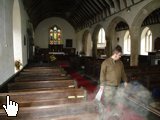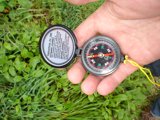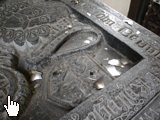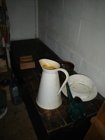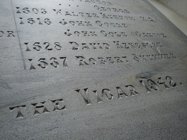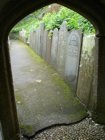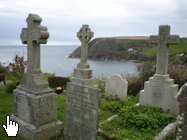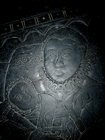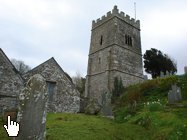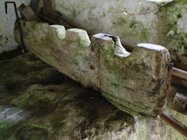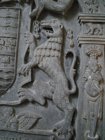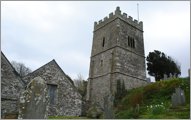
|
Name: Talland Bay, Church Location: Talland Bay, South East Cornwall, England Weather: Overcast, but bright. Temp: 11°C approx. Investigators: Jonathan, Matt, Patsy Map Ref: OS Map. |
| - |
Headless horsemen, demons
and smugglers: Perched, breathtakingly, on the clifftops above the
beautiful Talland Bay, the parish church is a must for those who adore
a little prettiness with their ghosthunting. The large building has
been adapted over time, from a pre-Christian Celtic church (the altar
is still in the same place), to the large rambling complex we see today,
with adjoining tower. Painted, photographed and sketched a thousand
times, the church has its fair share of legends and folklore. These include: The frightful tale of the desperate horseman, whose cart has been seen racing down the lanes, past the church and around the Bay, before disappearing on its fateful journey to the nearby harbour town of Polperro. The rider is thought to be fleeing the customs men, with his illegal bounty of rum. Shot several times, the man was dead before arriving at his destination, but the horse raced on, over the edge of the harbour wall and into the depths below. Or, how about the bizarre stories surrounding Reverend Richard Dodge (vicar of Talland from 1713-47), who was thought to possess the power to lay rest to wandering ghosts, raise demons at will, and stalk the dark country lanes each evening on the look out for wandering locals. Modern theory suggests Dodge was in league with crafty smugglers, who utilised his frightful stories to provide much needed secrecy from spying eyes. Or, how about the comtemporary reports of hearing a woman sobbing, from somewhere inside the building, but no source or person can be located, upon entering the church. This has been mentioned by more than a few visitors.
Lastly, there's the intriguing story of "Robert Mark". Resident of the nearby harbour town of Polperro, Mark was shot dead in 1802, although there is some confusion as to whether he was a local smuggling hero (shot at sea) or a customs/revenue man shot on duty. A stone (tablet style) memorial can be found in the church Baptistery (by the font, in the south west corner) upon the wall, and states "In prime of life, most suddenly, Sad tidings to relate, Here view my utter destiny, And pity my sad state. I by a shot which rapid flew, Was instantly struck dead." Now, tell me if I'm wrong, but I sense a little bitterness there, so Robert Mark may be a good focus for our investigation. Just as the first drops of rain began to fall, and the Bay disappeared into a rainy fog, we made our way into the church at Talland Bay….. |
| - |
| - |
The investigation: 06/04/05 :: From 13:30 to 17:30.
The first thing that struck us, was how odd it was to find a church with a detached tower. A small, and rather pretty, porch allows access to both buildings. At the foot of the tower steps (carved from solid bedrock), the old village 'stocks' lay, unloved and rotten. It is here that we placed our "trigger object" in the form of an ink pen, placed upon an A4 sheet of paper (during some investigations, it is thought that ghosts are able to move objects. This simple test explores that possibility). A line was drawn around the object, and we proceeded through the main door, into the nave of the church. Like all isolated country churches, the building seemed silent, and empty, but Patsy felt a strong sense of being watched, or "judged", as we stood taking in the atmosphere around us. I personally feel this is a common sensation in these environments. Going our separate ways, we began a sweep of the interior, using the tools brought specially: A compass: I found nothing too surprising, on my sweeps of the building. A minor fluctuation was encountered near the tomb of "John Bevill", who rests next to the site of the original Celtic alter. The tomb is made from Delabole slate, a material used throughout Cornwall during the 16th and 17th centuries. Perhaps the material itself has unknown magnetic properties, or this corner of the building masks something stranger underground. A further sweep, of the same spot, was made outside some time later, but no fluctuations were encountered (see illus). Note: I should also note that the tomb appeared to be littered with broken glass, from a broken bulb (see illus). Normally, the bulb would reside in a 70's style fixture above the tomb. Could this be the work of vandals (which seems unlikely), or something more? Digital Camera: Patsy was appointed official photographer today, and proceeded to wander the church, photographing anything which drew her attention. (204 photographs were taken during the course of the investigation!) Of note, we have included images of a bright light shard, in the bottom right corner by a lancet window, and a thick mist/trail appearing around Matt in the North aisle. It is possible for us to rule out condensation from Patsy's mouth, as the interior was warm, and no condensation appeared on our breath. No power fluctuations/errors affected the camera, and much of the photographic material was unexciting, although very pretty. Digital Dictaphone: Matt placed this device, set to 'on', by the stone tablet bearing the name of Robert Mark, the smuggler/customs man shot in 1802, and much grieved over by the people of Polperro. I said a few words of comfort, and confidence to the air around the stone, and retreated to other areas of the building. Our movements, and occasional gusts of breeze, are very audible, but nothing out of the ordinary was recorded. I personally found this very disappointing, but perhaps relying on a mere stone (rather than the actual scene of Robert's death in Polperro) for activity was rather fanciful. Other findings: We each found a comfortable position among the pews, and sat in silence for 2 hours. A few wandering tourists entered, wandered the aisles and left as silently as they arrived.
At 16:56, we all heard another sharp metallic sound, from the direction of the "Bevill Tomb" mentioned above. You will already know that I discovered broken glass on this casket, but I failed to mention the rusted metal breast plate which hangs upon the wall. To my eyes it looked a little like an English Civil War cuirass, worn by "Pikemen". It is without any doubt that we can state that the "clink" type sound came from this item, as if something was thrown in its direction. Trigger Object: Most surprising of all, the trigger object did not move. We were all ready to debunk any movements that day, as several tourists had come and gone, and a strong breeze was blowing from the south west. Oddly, the pen didn't move. At all. |
| - |
| Additional images: |
|
|
In retrospect: As I sit writing this page, I find I have very fond memories of Talland Church. A very pleasant afternoon was had by all, with the compass fluctuations being a favourite moment. The 50p guide book rests upon the desk, next to me, and has provided a wealth of further information. I'll keep it brief, but the brest plate armour is actually Spanish in origin. No reason is given for its position above the tomb. Also, I have learnt of the sad story of "Joanna Mellow", whose memory is recorded on a stone slab near the choir stalls. She, and her new born, both met their end in childbirth in 1625. Now, if I were more fanciful, I would suggest a possible connection to the sobbing woman, heard within the church by tourists and visitors. If you visit Talland, I strongly recommend the guidebook. It's bursting with facts, and intrigue, and mine emits a strong smell of mildew, old wood and stale air: the perfect cocktail to evoke memories of a perfect English country church on an overcast day, looking for ghosts.
|
| - |
| Lost in the web? Want to see further investigations? Visit thishauntedland.co.uk for more. |
| Copyright © XXv Productions 2004/2005 - All Rights Reserved |


